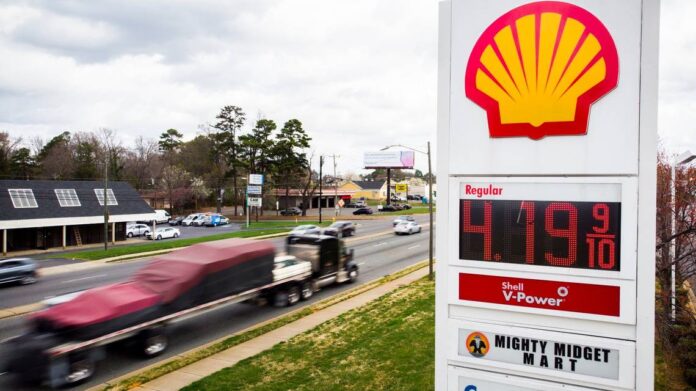READ MORE
Looking for more tips on saving money?
The News & Observer’s service journalism team is putting together a free
with tips to cut costs across several categories. We’ll be adding new stories often.
With inflation rising, we’re all looking for ways to save a little money and keep our budgets in check.
The News & Observer’s service journalism team is putting together a free Money-Saving Series with tips to cut costs across several categories.
In this installment, we’re offering up tips to save money on gas and travel costs — which you might be nervous about racking up as you head out on summer vacations. We’ll update this story with good tips we get from readers.
1/ Gas price apps in NC
With so many gas stations around, it can be difficult to keep track of gas prices and know whether you’re getting a good deal — or if you’re missing an opportunity to buy gas at a cheaper price nearby.
Thankfully, there are several apps that can help you keep track of prices and get price updates in real time, ensuring you’re getting the most up-to-date information on gas prices near you and finding the best price. Try one out the next time you need to fill up your tank.
Common and popular gas price tracking apps include:
▪ GasBuddy: gasbuddy.com/home; apps available for iPhone and Android users. Search by ZIP code to find prices near you, crowd sourced by other users.
▪ Gas Guru: Search “Gas Guru” on the Google Play store (play.google.com) or the App Store (apps.apple.com). CNN says this app pulls information from the Oil Price Information Service.
▪ Waze: waze.com/live-map; apps available for iPhone and Android users. This interactive map and GPS tool allows you to see real-time gas prices on your route.
2/ Gas rewards programs in NC
Most gas stations offer rewards programs that either help you save money up front by lowering the sticker price of gas, or help you get money back by offering cash-back or other rewards. Some grocery stores also offer fuel rewards.
The News & Observer previously compiled these gas rewards programs that are available in North Carolina:
▪ Circle K: With an Easy Pay card, you can save $0.30 per gallon for the first 100 gallons, then $0.10 per gallon for all fill ups after that, the website says. Easy Pay is linked to you checking account and combines with other discounts that the station is offering. Info: circlek.com/easypay
▪ Citgo: “When you open a CITGO Rewards Card account, you will earn 10¢ on every gallon* in fuel statement credits for the first 3 months, and 5¢ on every gallon* in fuel statement credits after the first 3 months at any CITGO location,” the website says. (Note, purchases are subject to credit card approval.) Info: citgo.com/motorists/payment-options/citgo-rewards-card
▪ Costco: Costco stores already have discounted gasoline, but the Costco Anywhere Visa Card by Citi can mean even more rewards. Earn 4% back on eligible gas for the first $7,000 spent per year, then 1% after. This card has other cashback rewards too, both at Costco and for other spending needs. Info: costco.com/gasoline-cash-back-rewards
▪ Exxon: The Exxon Mobil Rewards+ app can help you keep track of points at the pump. Earn $0.03 per gallon in points at the pump (and $0.02 per dollar in store) with a free Exxon Mobil Rewards+ account online. Every 100 points earns you $1 in savings, the website says. Info: exxon.com/en/rewards-program
▪ Harris Teeter: “For every 100 Fuel Points you earn, you can save $.10 per gallon on fuel purchases at Harris Teeter Fuel Centers and participating BP and Amoco stations, up to 1,000 points or $1.00 per gallon (maximum of 35 gallons) Harris Teeter’s website says. There is no limit to the number of Fuel Points you can earn in a month. Info: harristeeter.com/fuelpoints
▪ Lowes Foods: Save $0.05 per gallon for every $100 spent in store at Lowes Foods. These gas rewards can be redeemed at Speedway fuel stations in NC and SC. To redeem your fuel rewards, you’ll need to link your Fresh Rewards card with your Speedy Rewards card, Lowes Foods’ website says. Info: lowesfoods.com/savings-and-rewards/gas-rewards
▪ Sheetz: With the My Sheetz Rewardz loyalty program, get $0.03 off everyday gas, plus many in-store discounts and rewards, the website says. Info: sheetz.com/mysheetz-card
▪ Shell: Fuel rewards members save $0.05 per gallon, the website says. Info: shell.us/motorist/ways-to-save/fuel-rewards-program
3/ Limit your driving: Public transit in the Triangle & NC
It’s easier to save money on gas if you’re not actually driving everywhere.
Whether you’re headed on vacation or you’re just commuting to work, there are public transportation options in the Triangle and throughout North Carolina that can help you refrain from driving and save money while doing so.
While public transportation isn’t an option for everyone — you might live too far away from the Triangle’s more populous transportation hubs, or your destination might not be easily accessible along an existing route — and it might not be feasible to use it all of the time, opting to ride the bus when possible can be a good option for some people.
In the Triangle, bus options include:
▪ GoTriangle: gotriangle.org; connects major towns and cities in the Triangle.
▪ GoRaleigh: goraleigh.org; runs throughout Raleigh.
▪ GoDurham: godurhamtransit.org; runs throughout Durham.
▪ GoCary: gocary.org; runs throughout Cary.
▪ Chapel Hill Transit: chtransit.org; runs throughout Chapel Hill and Carrboro.
You can also limit your driving by taking Amtrak to destinations throughout North Carolina and the rest of the country. Not only will taking the train limit your spending on gas, but it can be a fun experience — and it will keep you from getting stuck in traffic en route to your destination.
▪ Learn more about Amtrak routes and schedules in North Carolina at ncbytrain.org.
4/ Slow down and drive the speed limit to save gas
While most people like to get to their destinations quickly — and safely! — going fast or driving over the speed limit can actually use more gas and cause you to spend more money in the long run.
AAA says that on the highway, “aerodynamic drag causes fuel economy to drop off significantly” once you start going over 50 miles per hour. (We know, most speed limits on major interstates are over 50 mph. But you can still drive as close to the posted limit as possible to avoid excess gas use.)
Try slowing down and driving the speed limit next time you’re looking to save on gas. Your wallet will thank you, and you’ll be a safer driver, too.
5/ Keep your car tires properly inflated to save gas
Making sure your car is well-equipped and properly functioning is also important to saving money on gas.
One tip from AAA is to keep your tires properly inflated.
“Underinflation reduces fuel economy, but more importantly, tires low on air degrade handling and braking, wear more rapidly and can overheat and blow out,” AAA says.
The U.S. Department of Energy says keeping your tires inflated to the recommended pressure can help you improve your gas mileage by up to 3% — the equivalent of saving up to 10 cents per gallon of gas.
Not sure what the recommended tire pressure for your vehicle is? For most passenger vehicles, it’s 32 to 35 pounds per square inch (PSI) when the tires are cold (when your car has been sitting overnight or at least for a few hours) — but you can double check the specifications for your car in your vehicle’s owner’s manual.
6/ Keep your parked car cool to save gas
When you get home after a long day of driving or even a short trip, where and how you keep your car parked can impact how much gas you use and how much money you spend.
That’s because the first thing most of us do when we get in our car the next time we need to drive, especially in the summer months, is turn on the air conditioning to cool it down.
If you’re keeping your car parked out in the open, instead of under a shady spot, your car will be hotter when you get in, and you’ll likely blast the A/C more to cool it down.
Try parking your car in a shady spot, like under a tree, to keep it cool when you’re not driving. Or, use a windshield screen to block some sunlight from getting in.
“This reduces the need for air conditioning (and thus fuel) to cool down the car,” AAA says.
7/ Use less air conditioning to save gas
It’s hot out there, we know. But limiting the use of your car’s air conditioning can help you conserve gas, and thus have to fill up less often.
“Even at highway speeds, open windows have less effect on fuel economy than the engine power required to operate the air conditioning compressor,” AAA says.
Whether you choose to drive with your windows down or just choose to bump up your car’s A/C settings a few degrees, limiting your A/C usage might be worth it to some people to save on gas — as long as you can stand a little heat.
Pro tip: If you use the tip above about keeping your parked car cool, you’ll already have a head start on this one, since you won’t need to blast your A/C as much to cool down your car when you get in each time.
8/ Plan trips and errands efficiently to save gas
We all know the feeling of going to the store, then getting home and realizing you forgot something and need to make another trip.
It happens to the best of us, but planning ahead by making lists and double-checking that you have what you need can keep you from making unplanned and unnecessary trips that waste extra gas.
You should also group trips in an efficient way to avoid the amount of time you’re driving and using gas. Plan to accomplish multiple errands in each trip you take, and plan your route in a logical way that avoids unnecessary mileage.
Pro tip: You can also plan your trips outside of high-traffic times for your area to avoid sitting in traffic and using more gas than necessary.
9/ Use cruise control to save gas
Headed out on a long trip? If you are — or even if you’re not — using cruise control can help you get the most out of the gas you buy.
Cruise control helps you maintain a constant and consistent speed, helping you save fuel — which means fewer trips to the gas station and less money spent filling up.
Pro tip: Remember the tip above about driving the speed limit? That also applies when using cruise control. Setting your cruise control well above the speed limit will defeat the purpose of using it at all.
Note: AAA says you should never use cruise control on slippery roads, “because a loss of vehicle control could result.”
10/ Avoid prolonged idling to save gas
Sometimes you just can’t avoid getting stuck in traffic. Or maybe you’re waiting for carside delivery at the grocery store or at a restaurant.
Whatever the case may be, if you find yourself in a situation where you’ll need to be stopped in your car for more than 60 seconds, AAA recommends shutting off your car’s engine to save gas.
Note: Many newer cars have systems that automatically do this for you, but if your car doesn’t have that feature, you’ll need to do it yourself.
Share your money-saving tips with us
Have a tip for saving money? Share it with us in the form below, or try accessing the form here.
We might use your tips in a future story.
This story was originally published June 16, 2022 2:43 PM.
Related stories from Raleigh News & Observer
Korie Dean is a reporter on The News & Observer’s service journalism team. She is a graduate of the Hussman School of Journalism and Media at UNC-Chapel Hill and a lifelong North Carolinian.













